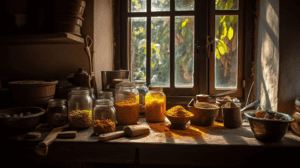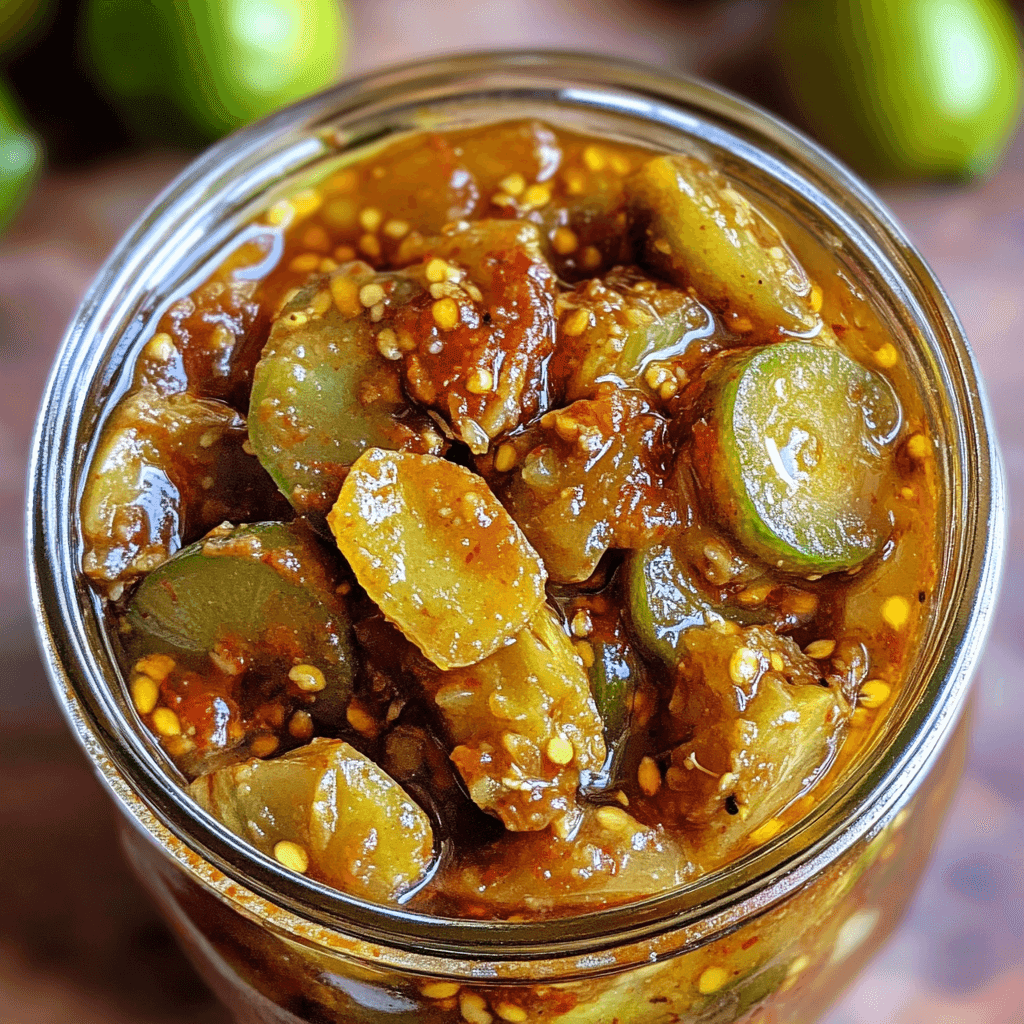Introduction to Indian Lime Pickle
What is Lime Pickle?
How to make Indian lime pickle involves creating a traditional condiment known as “Nimbu Ka Achaar.” This beloved pickle is celebrated for its vibrant tanginess and spicy kick, making it a staple in Indian households. Crafted from fresh limes, a blend of aromatic spices, and oil, lime pickle serves as a flavorful accompaniment to a variety of Indian dishes. Its unique combination of sour and spicy notes not only enhances meals but also preserves the limes, ensuring they last longer without refrigeration.
Historical Background
The art of pickling in India dates back thousands of years, serving as a method to preserve fruits and vegetables before the advent of refrigeration. Lime pickle, in particular, holds significant cultural importance across different regions of India. From the fiery pickles of Rajasthan to the tangy varieties of Kerala, each region brings its own twist to the preparation, reflecting local tastes and available ingredients. This rich history underscores the enduring popularity of lime pickle in Indian cuisine and its role in preserving food traditions.
Ingredients Required

Fresh Limes
The cornerstone of any good lime pickle is fresh, high-quality limes. Choosing the best limes is essential for a successful how to make Indian lime pickle. Select limes that are firm, vibrant green, and free from blemishes or soft spots. Fresh limes ensure a robust flavor and the right texture, which are crucial for a delightful pickle. Typically, medium-sized limes are preferred for their optimal balance of pulp and zest.
Essential Spices
Spices are the heart of crafting the distinct flavor profile of Indian lime pickle. The key spices include:
- Mustard Seeds: Adds a pungent flavor and acts as a preservative.
- Fenugreek Seeds: Contributes a nutty aroma and aids in preservation.
- Fennel Seeds: Provides a sweet, licorice-like taste that balances the sourness of limes.
- Red Chili Powder: Brings the heat and spice to the pickle.
- Turmeric Powder: Adds color and has antibacterial properties.
- Asafoetida (Hing): Enhances flavor and aids digestion.
Additional Components
Beyond the primary ingredients, you’ll need:
- Salt: Essential for seasoning and preservation.
- Mustard Oil: Preferred for its strong flavor and preservative qualities.
- Optional Additions: Garlic cloves or ginger can be added for extra flavor depth.
Step 1: Preparing the Limes
Selecting the Best Limes
Choosing the right limes is paramount when learning how to make Indian lime pickle. Opt for medium-sized limes that are firm to the touch, indicating freshness. Avoid any limes that feel soft or show signs of mold, as they can compromise the pickle’s quality and shelf life. Fresh limes will provide the necessary zest and juice for a flavorful pickle.
Cleaning and Cutting
Begin by thoroughly washing the limes to remove any dirt or residues. Dry them completely to prevent unwanted moisture from affecting the pickle. Using a sharp knife, make small slits or prick the limes to allow the spices and oil to penetrate effectively. Depending on your preference, you can cut the limes into halves or quarters, ensuring they’re manageable for storage and spice absorption.
Step 2: Toasting the Spices
Mustard Seeds
Mustard seeds are a fundamental spice in Indian pickles, imparting a sharp, pungent flavor. They not only enhance the taste but also act as a natural preservative, helping the pickle last longer. When cooked, mustard seeds release their oils, infusing the pickle with their characteristic aroma.
Fenugreek Seeds
Fenugreek seeds add a subtle bitterness and a nutty aroma to the pickle. They play a crucial role in balancing the sourness of the limes, creating a harmonious flavor profile. Additionally, fenugreek seeds aid in the preservation process, extending the pickle’s shelf life.
Fennel Seeds
Fennel seeds bring a sweet and licorice-like flavor that complements the tanginess of the limes. Their aromatic properties enhance the overall taste, making the pickle more palatable. Fennel seeds also contribute to the pickle’s digestive benefits, aiding in the digestion of rich meals.
Step 3: Mixing Spices with Limes
Combining Ingredients
In a large, clean mixing bowl, combine the dried limes with salt and all the toasted spices. The salt not only seasons the pickle but also draws out moisture from the limes, aiding in the preservation process. Ensure that the salt is evenly distributed to maintain consistency in flavor.
Adding Oil
Drizzle the mustard oil over the mixture, ensuring that each lime piece is thoroughly coated. Mustard oil is preferred for its strong flavor and preservative qualities, which help in extending the shelf life of the pickle. Toss everything carefully to distribute the spices and oil evenly, which is crucial for consistent flavor throughout the pickle.
Step 4: Sun-Drying the Mixture
Importance of Drying
Drying the lime mixture is a critical step in the pickling process. It reduces the moisture content, which helps prevent spoilage and ensures that the spices adhere well to the limes. Proper drying also facilitates the infusion of flavors, enhancing the overall taste of the pickle.
Drying Process
Spread the seasoned limes on a clean cloth or tray and place them under direct sunlight for several hours. The duration of sun-drying may vary depending on the weather conditions, but typically, 4-6 hours are sufficient. Stir the mixture occasionally to ensure even drying and prevent any limes from becoming too moist.
Step 5: Storing the Pickle
Choosing the Right Container
Transfer the dried and spiced limes into a sterilized glass jar. Glass is preferred as it does not react with the acidic lime juice and helps in maintaining the pickle’s flavor. Ensure that the jar is completely dry before adding the pickle to prevent any unwanted moisture from causing spoilage.
Storage Conditions
Seal the jar tightly to prevent exposure to air, which can degrade the quality of the pickle over time. Place the jar in a cool, dark area away from direct sunlight and moisture. Proper storage conditions are essential for preserving the flavor and extending the shelf life of the pickle.
Step 6: Maturation Period
Allowing Flavors to Meld
Allow the pickle to mature for at least a week before consumption. During this period, the flavors will meld together, and the limes will soften, absorbing the spices and oil. This maturation process enhances the taste, making the pickle more flavorful and aromatic.
Shaking the Jar
Shake the jar occasionally during the maturation period to redistribute the spices and oil. This ensures that every lime piece is evenly coated, promoting consistent flavor throughout the pickle. Regular shaking also helps in preventing any spices from settling at the bottom of the jar.
Step 7: Serving and Enjoying Your Pickle
Pairing with Meals
Indian lime pickle is incredibly versatile and pairs well with a variety of meals. It’s an excellent accompaniment to rice dishes, roti, parathas, and curries, adding a burst of flavor that enhances the overall meal experience. Its tangy and spicy notes complement both vegetarian and non-vegetarian dishes alike.
Creative Uses as a Condiment
Beyond traditional pairings, lime pickle can be used creatively as a condiment. Spread it on sandwiches or wraps for an extra kick, mix it into marinades for meats and vegetables, or use it as a dip for snacks like samosas and pakoras. Its robust flavor can elevate everyday dishes, adding a unique twist.
Tips for Perfect Lime Pickle
Maintaining Cleanliness
Hygiene is vital in pickling to prevent contamination and spoilage. Ensure that all utensils, bowls, and jars are thoroughly sterilized before use. Cleanliness minimizes the risk of unwanted bacteria infiltrating the pickle, ensuring it remains safe and delicious for extended periods.
Balancing Flavors
Achieving the right balance of tangy, spicy, and salty flavors is key to a perfect lime pickle. Follow the recipe measurements closely, especially when it comes to spices and salt. Adjusting the proportions can help tailor the pickle to your personal taste preferences without overwhelming the natural lime flavor.
Proper Storage
Store the pickle in a cool, dark place away from direct sunlight and moisture. Proper storage conditions help maintain the pickle’s flavor and extend its shelf life. Using airtight containers prevents exposure to air, which can degrade the quality of the pickle over time.
Common Mistakes to Avoid
Using Unripe Limes
Using unripe or overripe limes can negatively impact the pickle’s flavor and texture. Unripe limes may lack the necessary acidity, while overripe ones can become too soft, making the pickle mushy. Always select limes that are firm and ripe to ensure the best results.
Over-Spicing
While spices are essential, overusing them can make the pickle too spicy or bitter. It’s important to adhere to the recipe’s spice measurements, especially when experimenting with additional spices. Start with recommended quantities and adjust gradually to avoid overpowering the lime flavor.
Incorrect Storage Methods
Improper storage can lead to spoilage and a decline in pickle quality. Ensure that jars are sealed tightly and stored in appropriate conditions. Avoid placing the pickle near heat sources or in humid environments, as these can accelerate spoilage and alter the pickle’s taste.
FAQs
How long does Indian lime pickle last?
When stored properly in a sealed jar away from direct sunlight and moisture, Indian lime pickle can last for several months to a year. Regularly check for any signs of spoilage, such as off smells or mold, and ensure that utensils used are clean to maintain its longevity.
Can I use bottled lime juice?
For the best flavor and texture, it’s recommended to use fresh limes. Bottled lime juice lacks the zest and pulp that fresh limes provide, which are essential for the authentic taste and consistency of the pickle. Fresh limes ensure a vibrant and tangy flavor that bottled juice cannot replicate.
What spices can I add for variety?
You can experiment with additional spices like garlic, ginger, or even a touch of sugar to create unique flavor profiles. Adding ingredients like chili flakes or hing (asafoetida) can also introduce new dimensions to the pickle. Adjust the spices according to your taste preferences to customize your pickle.
How do I know when the pickle is ready?
The pickle is ready when the limes have softened, and the flavors have fully melded together. The oil should have permeated the limes, and the aroma should be rich and spicy. Taste a small piece to ensure the balance of flavors is to your liking before considering it fully matured.
Is it possible to make lime pickle without oil?
While oil acts as a preservative and enhances flavor, it’s possible to make a dry version of lime pickle without oil. However, this version may have a shorter shelf life and a different taste profile. If you choose to omit oil, ensure that the pickle is kept in a cool, dry place and consumed within a shorter timeframe.
How to extend the shelf life of lime pickle?
To extend the shelf life, store the pickle in sterilized glass jars and keep them in a cool, dark place. Always use clean utensils when handling the pickle to prevent contamination. Additionally, ensuring that the limes are thoroughly dried and properly spiced can help preserve the pickle for a longer duration.
Conclusion
Crafting Indian lime pickle at home is a fulfilling endeavor that connects you with India’s rich culinary traditions. By following this ultimate 7-step guide on how to make Indian lime pickle, you can create a delicious and tangy pickle that not only enhances your meals but also brings a burst of authentic flavors to your dining table. Remember to use fresh ingredients, maintain impeccable hygiene, and allow the pickle ample time to mature for the best results. Whether you’re pairing it with traditional dishes or experimenting with creative uses, homemade lime pickle is a versatile condiment that adds zest and excitement to any meal.
Related article:

